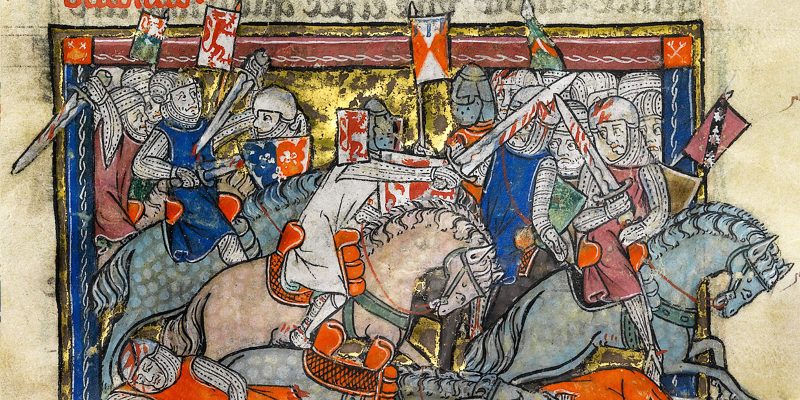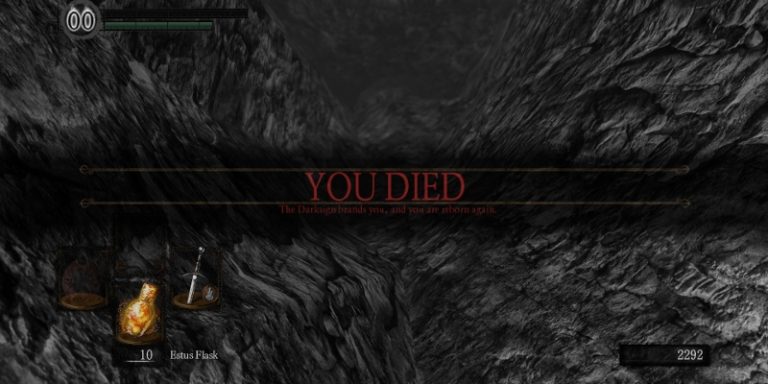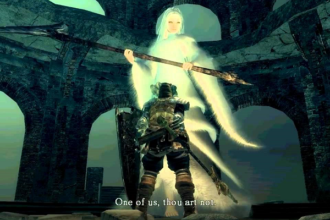Guilt, Dark Souls, and the Buried Giant

“That’s true, good lady, but then we boatmen have seen so many over the years it doesn’t take long to see beyond deceptions. Besides, when travellers speak of their most cherished memories, it’s impossible for them to disguise the truth.”– the boatman
Kazuo Ishiguro’s latest book, The Buried Giant, is incredibly good. The book confused a lot of critics as the book is an out-and-out fantasy tale, a far cry from his other books. His last work, Never Let Me Go, was a sci-fi novel regarding humanity, but for some reason fantasy novels don’t get the same leeway as sci-fi works. There is probably a lot of commentary out there about this very thing, so I won’t dwell on it too much. What I do want to discuss is how the book uses a fantasy setting to discuss guilt and remorse on a level I have never seen before, why I recommend the book to anyone who has wanted to know what playing Dark Souls is like without ever playing it, and how various settings can benefit from a deep exploration of emotional catharsis, even serving as the entire campaign story.
The Buried Giant is like Dark Souls in many ways. It is a very Japanese story told through Western motifs and iconography, and much of the storytelling relies upon the reader’s interpretation of events. This is far from an accident, as the book is constantly asking, “what exactly is memory, and what purpose does it serve?” The story takes place in England just after the reign of King Arthur, and the defeat of the Saxons by the Britons. Two older Britons, Axl and Beatrice, are an elderly couple living in a small hillside community, suffering what seems to be group memory loss, where they have begun to lose autonomy due to their advanced age. They are far from the communal flame, the only heat and light source within the hill. Worse, they are no longer allowed to have a candle in their home, for fear the they will tremble and shake in their advanced age, dropping the candle and starting a devastating fire.
In both The Buried Giant and Dark Souls, fire and light are important symbols. In traditional Japanese culture, fire is viewed as the representation of energy, movement, and force. Additionally, it represents the mental and emotional realms, guiding passion, desire, and intention. Ishiguro consistently has fire denied to the primary couple. Many of their conversations revolve around Beatrice expressing concern at the situation, and Axl reassures Beatrice that things will be all right, as they are accustomed to the darkness. Ishiguro contrasts their natures, between movement as represented by fire, and complacency and inaction as represented by darkness.
In Dark Souls, much of the story revolves around the First Flame, the fire from whence the four Lord Souls, Gwyn, Lord of Sunlight; Nito, Lord of the Dead; the Witch of Izalith; and the Furtive Pygmy, sprung and gave contrast to the cold, dark world of the age of dragons. Gwyn, Lord of Sunlight, began to fear the fire fading, plunging the world back into darkness. The Witch of Izalith attempted to recreate the First Flame, but unleashed chaos flame instead, consuming her and her children, and thus creating the Bed of Chaos, the home of demons, from their remains. Gwyn then split his soul amongst his children, using the remainder to link himself to the First Flame and allowing light to remain a while longer. With the fire now eternally burning, darkness is staved off completely. Dying no longer is a final end, and many become marked with the Darksign, which causes them to be reborn from bonfires, magical fires all linked to the First Flame, upon death.
As they die over and over, the undead lose their sense of self and the vestiges of what makes them human. When their humanity and memory is gone completely, they become wretched, feral things. They become Hollow. The people of the world feared the undead, and sent them away to dwell in an asylum, far from the rest of the world. It is important to again stress the role of memory being tied to will and sense of self, as well as similarities between Axl and Beatrice being ostracized from their community with the fear of the Darksign.
Axl and Beatrice decide to leave their community to visit their son, whose existence they barely remember. Once they recall he exists, they become more and more certain that he is waiting for them, and is likely anxious that he does not live with them and is not taking care of them. As they travel to reunite with him, they are troubled to discover that the entirety of the land suffers from powerful issues of memory loss. In some cases, particularly in a Saxon town, the memory loss is so bad people entirely forget what they were doing only moments later, reverting to a previous memory or belief.
In Dark Souls, most NPCs you encounter suffer from powerful memory loss, as they are slowly becoming Hollow from countless deaths and their inability to sustain their will and retain their humanity. Most will tell you stories before trailing off and losing a sense of themselves. Many will hold conversations with you as if you are someone different, or they have forgotten who you are since you began speaking with them.
Along their journey, Axl and Beatrice are trapped in a rainstorm and seek shelter within an old Saxon manor house, which Beatrice remembers are being beautiful upon her last visit through the woods not so long ago. The house is long decayed, and does not match Beatrice’s recollection even a little. Inside they find a silent boatman and a woman appearing to torture a rabbit. The woman claims the boatman took her husband to an island where they could live together forever, but upon taking her husband across the boatman refused to take her as well. The boatman claims no one goes to the island together, and when they arrive they never see a living soul again. The woman claims couples can go together, which the boatman agrees is true, but only if they manage to answer the question posed to them.
Axl and Beatrice run off the woman, and take the boatman’s side. Beatrice is eager to know the boatman’s question; he responds that he simply asks for their most cherished moments. This troubles Beatrice, who dwells upon it for much of the rest of the novel, while Axl is content to think no more of it. Beatrice worries that the fog covering the country is responsible for the memory loss, and it would be impossible to know what the most cherished memories would be, as so much of the past is forgotten. Axl insists that they know their lives now, and how could they not have had a wonderful life?
Along the way, Axl and Beatrice encounter Wistan, a Saxon warrior willing to travel with them, who seemingly remembers Axl, but neither of them are certain from where, and Edwin, a young boy who Wistan rescued from ogres. Wistan has been sent on a mission to slay the great she-dragon Querig. They also encounter Sir Gawain, one of the Arthurian knights. Sir Gawain is incensed by Wistan seeking to slay the dragon, for it is a task given to Sir Gawain to accomplish, though it has been many years now and he has not done so.
If this seems familiar to you, it is because there are a lot of similarities in this tale and in Dark Souls. Solaire of Astora is a great warrior who has come seeking the sunlight, and willingly subjected himself to the Darksign. Knight Lautrec is put in a similar situation to Sir Gawain, with obvious and unfortunate parallels. In fact, you even have Siegmeyer and Sieglinde, who can easily be seen as having similarities to Axl and Beatrice, save for changing the meaning of the relationship but otherwise keeping it intact.

Emotional Responses
The Buried Giant is really about how we process guilt and anger. Over the course of the novel, it is clear Axl once was an ambassador to the Saxons on behalf of Arthur, and he gave up his rights and title after the slaughter of innocent civilians. This measure prevented war for a generation, but all were ashamed of their actions. The great wizard Merlin used the breath of Querig to weave a curse, in which her breath inundates the land and brings memory loss. Sir Gawain, far from seeking to kill the dragon, was Querig’s protector. Upon the dragon’s death, memories begin to return.
While this is bleak, it is not as hopeless a message as you might think. Wistan and Edwin remember Axl and Beatrice with kindness. Wistan even remembers Axl strongly from his childhood, as a man who was unaware his words would ring false due to the actions of others. Wistan bids them part in peace, and says that the next time they meet, that peace would hold, though a greater peace was sure to fail. Axl and Beatrice remember that their son is long dead, and it was Axl who forbade Beatrice to attend the grave of their son, after discovering that Beatrice had an affair. However, as Axl says to the boatman, encountered once again at the end of the book, it was a wound healed in time, and this journey is proof enough of healing. The very end is ambiguous, as Axl quarrels with the boatman, and the boatman takes Beatrice to the island first, while Axl waits. It is never clear if Axl is able to join Beatrice or not.
Boy, doesn’t this remind you of deciding to link the First Fire to continue the age of light or to plunge the world back into darkness? It sure did when I finished reading it.
Regardless, both the book and the Souls games do something fantastic: they hang the core story off of powerful emotional resonance. While both do it in a traditionally high fantasy setting, there is a recently released 5e setting terribly appropriate for it – Ravenloft. Gothic Horror is about emotional resonance at its core. Dracula is an extended metaphor for sex and desire. Frankenstein is about grief and the lengths people go to in order to hold on to their loved ones, or work to keep their loved ones safe. In the original renditions, the domain of Strahd directly relates to his profound guilt. I say original because I have no idea how it stands now. It’s probably the same, dealing with his brother’s wife. Lord Soth’s time in Ravenloft is another great example. For Lord Soth, it was pride and denial leading to the state of his realm. As a general trend, I think this didn’t end up sticking around, as more and more domains ended up being vignettes about particular tales, drawing upon particular scenes from King Lear and Hamlet as examples.
There are endless possibilities here, and all of them are easy ways to build a complex, compelling emotional framework for a campaign with very little heavy lifting on the part of the designer. The simplicity of “the dragon’s breath has suppressed all memories” is brilliant, and when coupled with all of the encounters being themed around the exploration of memory, truth, and guilt? It’s incredible.
For example, you could run a campaign with a central theme of despair. The god-queen who sat upon the throne has not emerged from the castle in years, and the land is dying without her constant attention. The campaign themes might be hope, duty, and the nature of responsibility and sacrifice. These are broad categories, but they probably have formed two or three immediate ideas in your head just by reading them. That’s the true benefit of working from an emotional framework. It’s a straightforward approach allowing you to easily express story and themes, while allowing them to be easily communicated to the players.
This isn’t groundbreaking world- or campaign-building, by any means. However, it is likely not many people have attempted to build a world or campaign in this fashion. I can’t think of anyone I know who started from this angle, and I think it’s something worth exploring. Even if you disagree, you should play Dark Souls, Demon Souls, and Bloodborne, or at least check out The Buried Giant.



